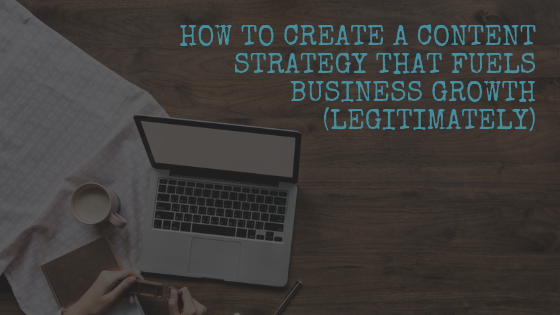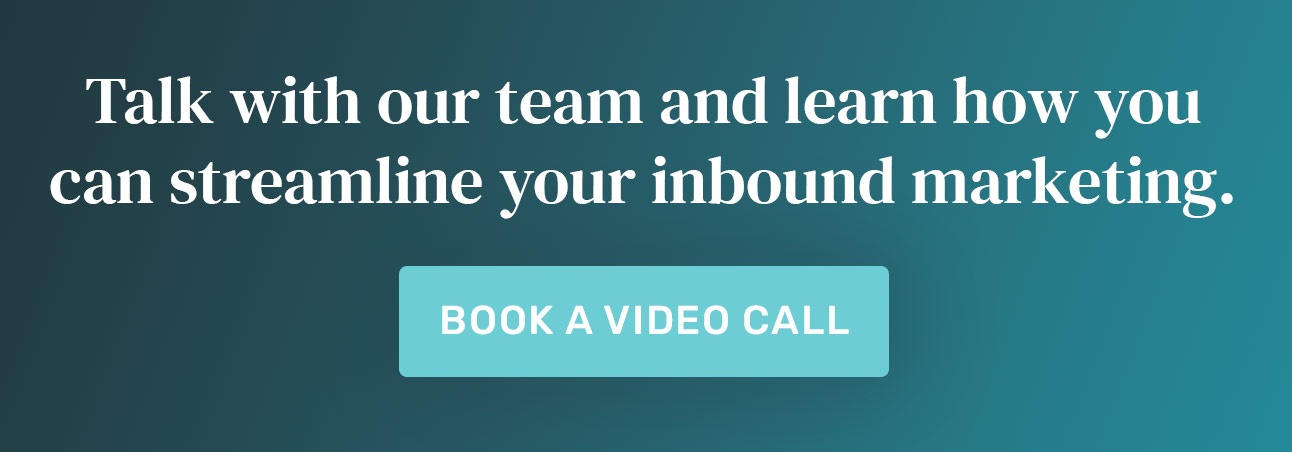How to create a content strategy that fuels business growth (legitimately)

If you run a business, then you’ve likely been hearing about content marketing for a while now. And if you’ve tried implementing this vague thing called content marketing over the last few years, you’re not in rare company if you haven’t really figured out how content marketing actually contributes to your business growth.
I don’t blame you. It’s one of those overly simplistic concepts that so many people have “thought leadership” on but really unhelpful ways to practically implement content here and content there to actually generate a financial return (because Facebook Likes and website traffic don’t show up on your income statements).
But without throwing the baby out with the bath water, you can—and should—still create a pragmatic content strategy for your business because doing so is a necessary step to staying relevant and competitive in the world we do business today.
The right approach to content marketing
The reason why content as a medium works for businesses is because our customers (B2C and B2B alike) live in a knowledge-based culture, and so we all consume content in order to acquire more knowledge of fill-in-the-blank. But content is not the end in itself, it’s simply a means we use to add value to our prospective customers in the state their currently in. The context of each piece of content is invaluable to the contribution of the knowledge-based value our prospective customers seek.
|
“Content is king, but context is god.” |
If your content isn’t adding value, why would your customer exchange value for your business in return?
The right focal point for creating a content strategy
Your starting point for creating a content strategy isn’t profound, but because I’ve seen and worked with so many businesses that miss this I’m starting to think it might not be so obvious.
So here it is: your business’ content strategy must start with who your audience is (and by audience, I mean customer). In fact, your customer audience is who your content strategy starts with, ends with and revolves around everywhere in between.
Now, assuming you’re already familiar with content marketing, I’m also going to assume you’ve likely heard marketing thought leaders say this and immediately jump to “customer profiles.” Here’s why so many marketing thought leaders give you the advice of starting with building personas—it makes you zero in on who your customer is—who they are, what they like, what they want, what problems or challenges they face, etc. In the marketing world, we often break this down to demographic, geographic, psychographic and behavioral graphic data. Ultimately, the point of it all is to know as best you can who your customer is.
So what’s more effective than hypothetically formulating who your customers are? Letting data tell you who your customers are. So whether that’s CRM or other marketing analytics data of existing customers or even better, literally talking to customers, you will not only reorient your focus on who your business and your content should serve, but you’ll have accurate, data-based inputs to inform you who your business serves.

The right messaging for your content strategy
Now that we’ve established the right approach and right focal point for your content strategy, the next critical step is to ensure your business is communicating the right messages to the right audiences. There are three questions to ask to pinpoint the right messages you need to be communicating with your content:
1. Is it clear?
First and foremost, your business absolutely must make sure every bit of your marketing communication is clear. Crystal clear. If your audience doesn’t understand what your content is communicating, the content is worthless.
Donald Miller, a communications expert, New York Times’ Bestselling Author and CEO of StoryBrand utters a phrase on repeat when he talks about the importance of clarity: “If you confuse, you’ll lose.”
Cut the jargon. Stop using acronyms. Don’t write a piece of content at your level of understanding. Create content that your audience can understand clearly. If you don’t truly know what your audience will understand, then create content with such clarity that a 10-year-old will understand it.
2. Is it relevant?
Relevancy is one of the primary drivers for media being distributed and consumed today. It’s one of the most important factors that drive the distribution of content behind the algorithms of Google, Facebook and Twitter. And for good reason. People consume content that is relevant to their personal experiences at any given moment.
If I’m making stuffing for Thanksgiving dinner from scratch this year, I’m going to consume content that will help me figure out how to make stuffing. If I’m scrolling through LinkedIn and see a piece of content about the 2019 marketing trends to know as a marketer, I’m probably going to read it because I’m a marketer and it’s 2019.
But remember, not only does the content have to be relevant to your customer’s experience, but the context of the content must be relevant.
As industry experts in our respective lines of business, our tendency is to talk about all the specs and details of our product or service at the in-depth level we find natural, and it’s easy for that level of insider speak to creep into our content.
But most of our customers are not industry experts in our field and honestly don’t really care about every spec and detail we provide, they just care that whatever solution we offer will solve a problem or fulfill a want they’re experiencing. Focus your content on the relevant contexts your customers are experiencing.
3. Is it helpful?
Along the same lines of relevancy, your audience is consuming your content in a specific context tied to a certain experience. Our experiences shape the intent behind why we consume content—be it leisure, be it education, be it entertainment, etc. But ultimately, whatever intent we have when consuming content informs the expectations we have from what the consumption of that content will provide us with.
If I’m watching a Jimmy Kimmel episode on YouTube, my intent to watch that episode is entertainment and my expectation is that the content will be funny, that it will make me laugh. If I watch an episode and I don’t find it funny, my expectations are not met.
If I’m reading a content piece titled “Thanksgiving Stuffing Recipe,” you better believe I’m expecting to see a recipe for stuffing. Imagine the disappointment and frustration I would experience if that article talked about the chemical impacts stuffing has on the human body without actually providing a stuffing recipe.
When we think about the content we create for our businesses, we need to be sure that the content we’re creating are helpful in the sense that each piece will provide whatever solution that consumer’s intent is for consuming.
The right business objective for your content strategy
Obviously, the point of actually executing a content strategy for your business is to help your business grow. There is no one silver bullet for every business as far as the perfect content strategy, but businesses should not start creating content just because it’s a recommended practice.
Every content strategy should be tied to real, tangible business objectives. These objectives will vary depending on your business, but there are a few steps any business can take to make their content strategy aligned with real business objectives:
Step 1: Define your businessgoals
Traditional business practices will tell you about setting SMART goals. Sure, these can be a bit arbitrary at times, but there’s a reason why these attributes to setting goals are staples in any business 101 class - they make goal setting specific and tied to data.
The same applies to your content strategy. Whether your content is purposed to drive revenue or simply educate an audience, it’s critical to establish goals that align your business objectives with all of the content you create. This keeps your content focused and allows you to measure the performance of your content in order to make continuous adjustments along the way as your audience behaves.
Step 2: Identify key performance indicators
Once your content goals are established, measuring your content performance is the only way to determine whether your goals are being met.
In a day and age where seemingly everything can be measured, it can be easy to become overwhelmed by analysis paralysis. Just like establishing specific goals can help focus a content strategy, identifying specific measurements will focus your ability to measure your content’s effectiveness and make informed decisions based on its performance.
Step 3: Choose your channels to test
Once you have an idea about the goals you’re pursuing for your content strategy and the metrics you will use to measure your content, you need to determine what channels you are going to publish and promote your content for your audience to access.
One of the most important elements to note here when selecting channels to distribute content is to approach the effort with the scientific method of hypothesizing and experimenting in mind. Marketing is a blend of both art and science, and the delivery of marketing content to an audience involves both elements to be effective.
Rather than committing to certain channels before you roll out your content marketing efforts, it’s okay to test a variety of channels to see which channels your audience engages with in the most effective and cost-efficient manners possible. Don’t be afraid to test a channel you are not sure will work, and likewise don’t be afraid to shut down a channel that doesn’t work just because it’s considered “best practice” to be in that specific channel.
Step 4: Measure your content and channels
After you plan your content strategy and begin creating content, this is where measuring your content becomes almost as vital as the quality of the content itself.
Foundationally, you want to be sure that you have the proper tools and frameworks established to reliably measure how people engage with your content aligned with the KPIs you previously identified.
Measuring your content’s performance and the effectiveness of each channel you utilize allows you to leverage real data to make decisions around how to change and improve content or the channels you’re deploying based not in assumption or best practice but in how your real customer audience actually behaves.
Step 5: Amplify what works
Finally, the success of a good content strategy comes from a combination of accurately identifying what works and making adjustments to amplify what works.
Just like a good football coach will continue to call plays to give the ball to the running back if their running game is working, so too good content marketing will be made even more effective through consistency with the tactics that perform best.
Ready for content marketing to make a significant impact on your bottom line? Contact us for a free inbound marketing consultation. We'll work together on a strategy that provides meaningful results for your business.

January 15, 2019
